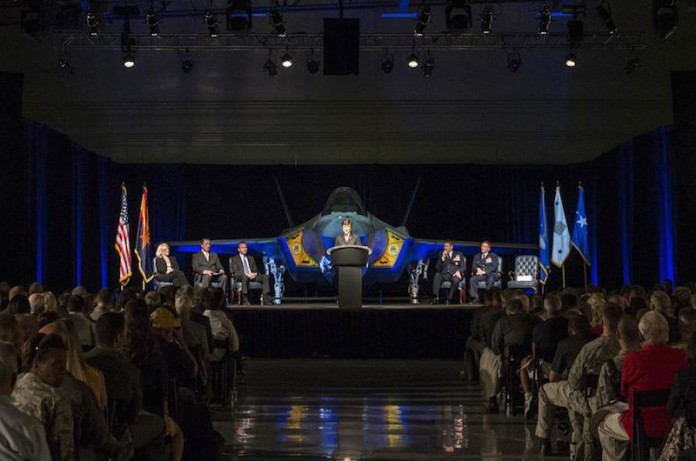
“The root cause of the incident still remains under investigation. Additional inspections of F-35 engines have been ordered, and return to flight will be determined based on inspection results and analysis of engineering data. Defense Department leadership supports this prudent approach.” The Pentagon announced.
Until this official announcement the F-35 fleet was under a “cautionary suspension of flight”, announced as a temporary measure until investigation details were available.
Despite this setback the Pentagon is still preparing to send four F-35Bs across the Atlantic Ocean to the UK, to participate in the International Air Tattoo and Farnborough Airshow
It was the first official endorsement of the incident on June 23, which involved a Low Rate Initial Production (LRIP 5) F-35A (not a test airplane) on a routine training flight. The fire that erupted in the third stage of the F135 engine ripped through the top of the plane Reuters reported and caused major damage to the engine and aircraft.
Update: “There’s a growing body of evidence that this may have been an individual situation, not a systemic one. But we don’t know that for certain at this point in time,” Defense Undersecretary Frank Kendall told lawmakers on a hearing of the House Armed Services Committee on Thursday July 10. The F-35 is still grounded, and its planned participation at the Air Tattoo has been cancelled, but it is still scheduled to make it to Farnborough July 14, if the jet is returned to flight status by Saturday July 12.
Breadcrumbs trails?
The last major stand down of the F35 fleet was ordered on February 22, 2013, three days after cracks were found in a turbine blade of one of the F135 engine. This grounding took a week to lift off.
At the time the engine manufacturer’s findings were that the crack detected in the third stage turbine of the F135 engine resulted from excessive stressful operating environment experienced in flight tests. The engine in which the crack was found was used on the second prototype, AF-2 and was operated at high temperatures for more than four times longer than a typical F-35 flight, this stressful regime has led to a separation of the grain boundary of the particular blade that experienced the crack.
After inspections of other F-35 fighter jets did not find similar cracks or signs of excessive engine stress, no redesign was required for the JSF F-135 engines and the fleet grounding was waved. Last month an engine oil leak forced mandatory inspections of the entire fleet of 104 F35 jets. Three of the aircraft failed that inspection.
Amos’ pressure is not merely political – a burning issue is the planned Initial Operational Capability (IOC) milestone for the corps’ first F35 – within 12-18 months
In September 2009 an F135 test engine was damaged amidst a simulated 11 hour supersonic test cycle. After investigating the cause of the damaged F135 the manufacturer, P&W said it will introduce minor changes to the engines, to prevent repeated occurrences. A month later another damage occurred to the competing F136 engine, developed by GE and Rolls Royce. At the time two engine manufacturers were competing on providing two different engines for the F35. Howerver, the development of the F136 alternative engine was terminated in 2011, after the two partners stopped work on the project after failing to gather Pentagon support for further development. Although the Pentagon has invested over two billion dollars in the program since 2004 the Pentagon and Joint Program office did not ask for funding for the alternate engine since 2006, while congress, on its side maintained funding and support of the program until 2010.
Having two engines supporting the operational fleet would mean that future fleet wide grounding of the F35 due to engine issues could be avoided.
Bad timing
Despite this setback the Pentagon is still preparing to send four F-35Bs across the Atlantic Ocean to the UK, to participate in the International Air Tattoo and Farnborough Airshow. A final decision will come early next week, Rear Admiral John Kirby, the Pentagon’s chief spokesman said.
The current mishap is much more serious and may also cause significant political fallout, as the cross-atlantic deployment of the aircraft was planned to make a strong statement of the JSF program and the international support it has gained in recent months. High level officials including Marine Corps Commandant Gen. James Amos who have lead the campaign to send the F-35B to the UK, are committed to get the aircraft flying as soon as possibly can, of course, without compromising safety. Therefore, the Marine Corps is likely to do its best effort to conclude the investigation and get a safety waiver for their type to resume flying. Amos’ pressure is not merely political – the burning issue is the planned Initial Operational Capability (IOC) milestone for the corps’ first F35 squadron, Marine Fighter Attack Squadron (VMFA) 121 currently based in Yuma, Ariz.
Based on the F-35 JPO schedule set in June 2013, the F-35B will reach the IOC milestone between July 2015 and December 2015. Marine Corps F-35B IOC shall be declared when the first operational squadron is equipped with 10-16 aircraft, and US Marines are trained, manned, and equipped to conduct CAS, Offensive and Defensive Counter Air, Air Interdiction, Assault Support Escort, and Armed Reconnaissance in concert with Marine Air Ground Task Force resources and capabilities.



















